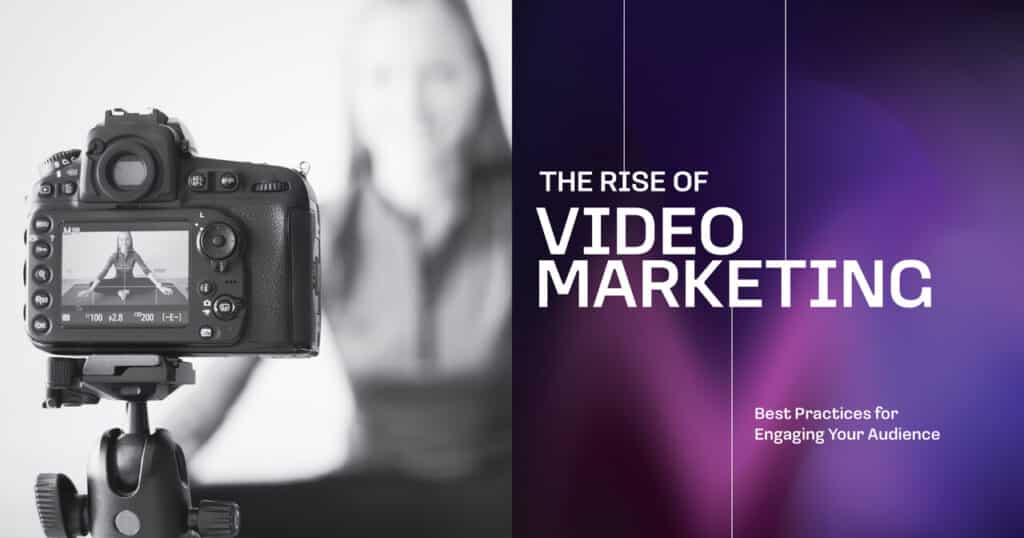Video marketing is no longer the future; it is in full swing before our very eyes and is settling well into the digital palette. For businesses looking to increase brand awareness or push conversions, video marketing is perhaps the most powerful medium for connecting with their audience. Changes in how consumers engage with their online content have made it a critical component of successful marketing plans.
Key Takeaways
- Video marketing boosts engagement, conversions, and trust.
- Use varied formats: short-form for attention, live streams for interaction.
- Stay ahead with personalized and interactive content.
This blog post will discuss the best practices for creating engaging video content, video formats to consider, distribution methods, and measurements of success. Let’s dive into how to tap into video marketing for your brand.
Why Video Marketing Is Dominating the Digital World?
Video content captures attention more effectively than any other format. Studies indicate that individuals retain a remarkable 95% of a message when they experience it through video, in stark contrast to a mere 10% retention when reading text. The synergy of visuals, audio, and storytelling captivates viewers, simplifying the conveyance of information and stirring emotions.
Video Consumption Trends in 2024
As TikTok, Instagram, and YouTube rise in popularity, so are video consumption. Online video consumption grows 100% year on year and is up to 16 hours a week. Video in social media strategies Video is now an indispensable part of marketing strategy for most businesses. Of all the companies that believe social media is important for their business, 86 use videos as a marketing tool. This will only grow with consumer demand for more and more interactive experiences.
The Core Benefits of Video Marketing
Why Video Is the Most Engaging Form of Content?
There is a good reason why videos garner higher engagement rates than text or images. Videos trigger multiple senses: sight, sound, and sometimes even text, providing immersive experiences that can’t be replicated by static images or text-based blog posts. Video captures attention, be it emotive storytelling or great visuals, which keep viewers glued for longer periods of time, thereby cutting down on bounce rates and increasing dwell time.
Increasing Conversion Rates With Video
Video content directly influences the behavior of consumers. Moreover, a landing page with video content can prompt up to an 80% increase in conversion rates, while an email with an embedded video may increase click-through by 200-300%. Versatility can help build trust and understanding: it could be a video demonstrating the product, an endorsement by customers, or an explainer type.
Boosting Brand Awareness and Trust
Video humanizes your brand. Whether through behind-the-scenes content, live streams, or customer testimonials, video builds a personal connection between the brand and its audience. This trust translates into better brand recall and customer loyalty, making video an essential tool for building and maintaining a strong brand presence.
Best Practices for Creating Engaging Video Content
Know Your Audience Before Creating Video Content
Ask yourself before you hit the record button: who am I making this video for? Understanding your audience is the first step in creating engaging content. Tailoring your video to the preferences, challenges, and interests of your target audience will help you make stuff that resonates. You should invest time in research—gathering data from surveys, social media insights, or competitor analysis, to learn what kind of videos your audience prefers, what platforms they spend time on, and what formats engage them the most.
Crafting a Clear Message
An effective video starts with a clear and concise message. Whether you’re explaining how a product works or telling your brand story, ensure the message is simple and focused. Avoid overloading your video with too much information, as this can confuse viewers or lead to disengagement. Stick to one central idea per video and let the content flow naturally from start to finish.
The Power of Storytelling in Video Marketing
Storytelling stands as one of the most powerful tools for captivating viewers. Individuals are drawn to stories, finding them relatable and emotionally resonant. As you craft a video, consider how to weave your content into a narrative that has a clear beginning, middle, and end. You might share customer experiences, offer a glimpse behind the scenes, or recount the journey of your brand. The essential element is to ensure the story feels genuine and forges a connection with your audience’s emotions and experiences.
Video Formats That Drive Engagement
Short-Form Videos for Quick Engagement
Short videos have become a favorite, especially with the emergence of TikTok and Instagram Reels. These usually range between 15 to 60 seconds in length, which makes them perfect for grabbing attention within the fast pace of the digital world. Shareable content highly becomes an instrument of conveying your message compactly and playfully.
Live Streaming for Real-Time Interaction
Live streaming stands as yet another formidable tool in your video marketing arsenal. Platforms such as Instagram, Facebook, and YouTube provide live streaming options that enable you to connect with your audience in real time. By hosting live Q&A sessions, product launches, or virtual events, you invite your audience to engage directly with your brand, pose their questions, and receive immediate responses.
Educational Videos and Tutorials
One of the most impactful forms of content is educational videos. Tutorials, how-tos, and explainer videos establish your brand as an authority in your field while delivering value to your audience. Moreover, these videos are evergreen, ensuring they attract traffic and engagement long after release. Whether you’re guiding your audience on utilizing your product or sharing industry insights, educational videos foster trust and provide lasting value.
Reaching Your Audience Effectively
Optimizing Videos for Social Media
Each social media outlet has its own unique best practices for video content. Videos on Instagram should be short and visually engaging, whereas on Facebook, they can be a little longer and more storytelling-style. LinkedIn is a good place for B2B video marketing, while TikTok thrives on creativity and trendy ideas. Understanding the nuance of each platform will allow you to reach your video better and engage with it in the right way.
Maximizing YouTube’s Potential
YouTube remains the world’s second-largest search engine, making it an essential platform for video marketing. To succeed on YouTube, focus on creating compelling thumbnails, video titles, and descriptions. YouTube videos should also be optimized for SEO, using relevant keywords to improve discoverability. With consistent posting and audience engagement, YouTube can drive long-term traffic to your business.
Embedding Videos on Websites and Emails
Videos aren’t just for social media. Embedded videos on your site will make it more enjoyable to visit, making users spend more time on the site. Whether it’s on a landing page, showcasing a product, or behind the scenes of your company on an About Us page, embedded videos will keep users longer engaged. Another benefit is adding video to an email campaign, which can increase open rates and click-through rates, thereby making your emails much more effective.
How to Measure the Success of Your Video Campaign?
Key Video Marketing Metrics to Track
Measuring the success of your video marketing efforts is crucial for optimizing future content. Some key performance indicators (KPIs) include:
- Views: The number of times your video has been watched.
- Engagement: Likes, shares, and comments indicate how well your content is resonating with the audience.
- Watch Time: This tracks how long viewers are watching your video. The longer the watch time, the better your video is performing.
- Click-Through Rate (CTR): This measures how many people clicked on your video after seeing it in search results or in their feed.
- Conversion Rate: If the goal of your video is to drive sales or leads, tracking conversions is essential to determine your ROI.
Adjusting Your Strategy Based on Performance
It is now time to analyze and refine those efforts once you have collected your video marketing metrics. Were some types of videos performing better than others? Was there a particular platform where the engagement or conversions were higher? Use these insights to fine-tune your approach for future campaigns. Continuing to analyze performance will allow you to improve your content and distribution tactics over time.
Emerging Trends in Video Marketing to Watch
Shoppable Videos and Interactive Content
Shoppable videos are changing the face of e-commerce. With a simple click on the product within the video, consumers can buy their product seamlessly from the video. This innovation eliminates the need for viewers to leave the platform and search for the product elsewhere, thus streamlining the buyer’s journey. For those brands seeking more conversions directly through video content, shoppable videos are the ideal solution.
Another cool thing about interactive videos is pure magic. Viewers can actually engage with the content even deeper. The videos empower the users to make choices about which storylines to pursue or order extra product information, hence creating a personal experience that amplifies engagement and retention.
The Role of AI and Personalization in Video Marketing
AI is making it possible for video marketing to shift on a hyper-personalization axis. Such AI tools would have the ability to combine personalized video content especially for individual viewers with regard to their history of browsing, preferences, and location. It might include sending customers video messages about the appreciation for their purchase, customized product suggestions, or an invitation to special events.
Future-Proofing Your Video Marketing Strategy
The rise of video marketing is undeniable and a phenomenon that will shape the future of digital marketing for years to come. By telling stories, using different video formats, and selecting the right distribution channels, brands can establish more authentic relationships with their audience and create high-intent engagement. As new trends and technologies emerge, such as shoppable videos and interactive content, and, more particularly, AI-driven personalization, those businesses that stay ahead will not be kept out of the game.
Let’s Boost Your Engagement With Video Marketing!
Ready to take your video marketing strategy to the next level? Contact us today for customized video marketing solutions that will captivate your audience and drive real results. Let’s collaborate to create impactful video content that elevates your brand.
FAQs
- Why is video marketing important in 2024?
Video marketing is essential because it drives higher engagement rates, increases conversions, and helps build trust with your audience.
- What type of video content should I create?
Focus on content that resonates with your audience, such as tutorials, explainer videos, product demonstrations, live streams, and behind-the-scenes footage.
- How can I measure the success of my video marketing campaigns?
Track key performance metrics such as views, engagement rates, watch time, click-through rates, and conversions to evaluate success.
- What platforms should I use for video marketing?
Platforms like YouTube, TikTok, Instagram, and Facebook are great for video content. Each platform caters to different audiences and video styles, so optimize your content accordingly.
- How do I increase the reach of my videos?
Optimize your videos for SEO, use engaging thumbnails and titles, promote videos on social media, and consider paid promotions to reach a broader audience.









